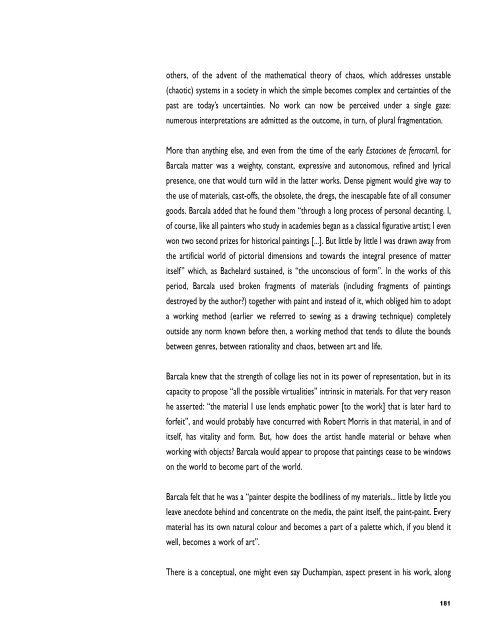Catálogo de la exposición - Fundación César Manrique
Catálogo de la exposición - Fundación César Manrique
Catálogo de la exposición - Fundación César Manrique
You also want an ePaper? Increase the reach of your titles
YUMPU automatically turns print PDFs into web optimized ePapers that Google loves.
others, of the advent of the mathematical theory of chaos, which addresses unstable<br />
(chaotic) systems in a society in which the simple becomes complex and certainties of the<br />
past are today’s uncertainties. No work can now be perceived un<strong>de</strong>r a single gaze:<br />
numerous interpretations are admitted as the outcome, in turn, of plural fragmentation.<br />
More than anything else, and even from the time of the early Estaciones <strong>de</strong> ferrocarril, for<br />
Barca<strong>la</strong> matter was a weighty, constant, expressive and autonomous, refined and lyrical<br />
presence, one that would turn wild in the <strong>la</strong>tter works. Dense pigment would give way to<br />
the use of materials, cast-offs, the obsolete, the dregs, the inescapable fate of all consumer<br />
goods. Barca<strong>la</strong> ad<strong>de</strong>d that he found them “through a long process of personal <strong>de</strong>canting. I,<br />
of course, like all painters who study in aca<strong>de</strong>mies began as a c<strong>la</strong>ssical figurative artist; I even<br />
won two second prizes for historical paintings [...]. But little by little I was drawn away from<br />
the artificial world of pictorial dimensions and towards the integral presence of matter<br />
itself” which, as Bache<strong>la</strong>rd sustained, is “the unconscious of form”. In the works of this<br />
period, Barca<strong>la</strong> used broken fragments of materials (including fragments of paintings<br />
<strong>de</strong>stroyed by the author?) together with paint and instead of it, which obliged him to adopt<br />
a working method (earlier we referred to sewing as a drawing technique) completely<br />
outsi<strong>de</strong> any norm known before then, a working method that tends to dilute the bounds<br />
between genres, between rationality and chaos, between art and life.<br />
Barca<strong>la</strong> knew that the strength of col<strong>la</strong>ge lies not in its power of representation, but in its<br />
capacity to propose “all the possible virtualities” intrinsic in materials. For that very reason<br />
he asserted: “the material I use lends emphatic power [to the work] that is <strong>la</strong>ter hard to<br />
forfeit”, and would probably have concurred with Robert Morris in that material, in and of<br />
itself, has vitality and form. But, how does the artist handle material or behave when<br />
working with objects? Barca<strong>la</strong> would appear to propose that paintings cease to be windows<br />
on the world to become part of the world.<br />
Barca<strong>la</strong> felt that he was a “painter <strong>de</strong>spite the bodiliness of my materials... little by little you<br />
leave anecdote behind and concentrate on the media, the paint itself, the paint-paint. Every<br />
material has its own natural colour and becomes a part of a palette which, if you blend it<br />
well, becomes a work of art”.<br />
There is a conceptual, one might even say Duchampian, aspect present in his work, along<br />
181















![Becas y premios de la Fundación César Manrique [1997-2006]](https://img.yumpu.com/20766851/1/184x260/becas-y-premios-de-la-fundacion-cesar-manrique-1997-2006.jpg?quality=85)
